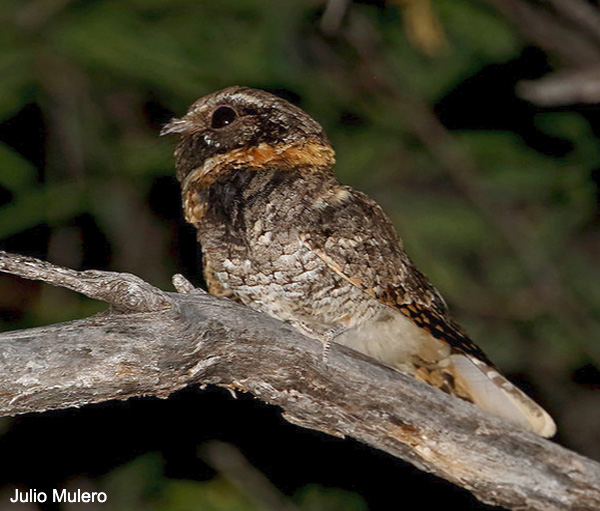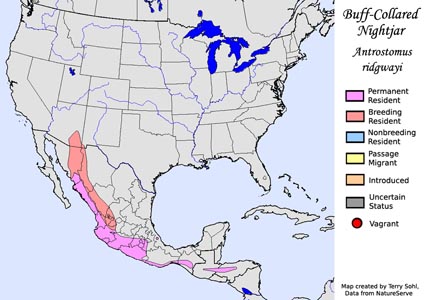| Length: 9 inches | Wingspan: 15 inches | Seasonality: Non-resident in South Dakota |
| ID Keys: Dark overall with mottled darker and whiter ares, distinctive, obvious ruddy-colored collar that's lighter in the front of the neck | ||
 The
Buff-collared Nightjar is similar to other nightjars in overall appearance,
with a dark body with various brown, whitish, and black mottling. Their
trademark buff-colored collar makes them easy to distinguish from other
nightjars found in their range. They are found throughout dry woodlands and
forest clearings of western Mexico, and were unknown in the United States
until 1958.; However, since then they have occasionally been found as summer
breeding birds in far southeastern Arizona and, more rarely, in southwestern
New Mexico. Even there they are generally rare, with only a handful found
each breeding season.
The
Buff-collared Nightjar is similar to other nightjars in overall appearance,
with a dark body with various brown, whitish, and black mottling. Their
trademark buff-colored collar makes them easy to distinguish from other
nightjars found in their range. They are found throughout dry woodlands and
forest clearings of western Mexico, and were unknown in the United States
until 1958.; However, since then they have occasionally been found as summer
breeding birds in far southeastern Arizona and, more rarely, in southwestern
New Mexico. Even there they are generally rare, with only a handful found
each breeding season.
Habitat: Found in dry woodlands and forests, including forest edges and scrubland. In the US portion of their range, they are found in dry, low- and mid-elevation canyons, in areas with acacia, mesquite, and other shrubland.
Diet: Feeds on a insects
Behavior: Nocturnal, feeding on insects at night, using it's wide, gaping mouth to scoop up insects while in flight. Foraging flights are made from observation posts on the ground, or in a shrub or tree.
Nesting: The nest of a Buff-collared Nightjar is placed on the ground. They often simply use a dry shady patch of bare dirt, or an area of fallen leaves. They lay one or two eggs, with the female doing all the incubation. The eggs hatch after about 3 weeks.
Song: The song of a Buff-collared Nightjar is a fast series of rising "kuk-kuk-kuk" notes, ending with a more complex three- or four-note phrase.
Migration: Birds in most of the Mexican range are permanent residents, although some may disperse short-distances after breeding (particularly to lower elevations). Those in the far northern part of their range, including those found in the United States, are only summer breeders and move southward for the winter.
Interactive eBird map: Click here to access an interactive eBird map of Buff-collared Nightjar sightings
Similar Species: Whip-poor-will,
Conservation Status: Populations do appear to be in decline. However, numbers have not declined sufficiently for strong conservation concern at this time. The IUCN considers the Buff-collared Nightjar to be a species of "Least Concern".
Further Information: 1) Cornell's NeoTropical Birds - Buff-collared Nightjar
2) Audubon - Buff-collared Nightjar
3) WhatBird - Buff-collared Nightjar
Photo Information: Photo licensed under Creative Commons Attribution/Non-Commercial/NoDerivs 2.0 Generic License - Photo by Julio Mulero - May 28th, 2017 - Santa Cruz County, Arizona
| Click below for a higher-resolution map |
 |
| South Dakota Status: Non-resident in South Dakota |
Additional Buff-collared Nightjar Photos (coming soon!!)
